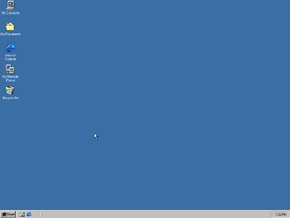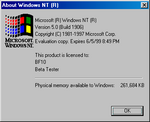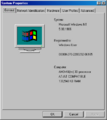Windows 2000 build 1906
| Build of Windows 2000 | |
 | |
| OS family | Windows NT |
|---|---|
| Version number | 5.0 |
| Build number | 1906 |
| Build revision | 1 |
| Architecture | x86 |
| Compiled on | 1998-10-07 |
| Expiration date | |
| Timebomb | +240 days after original install date |
| SKUs | |
| Workstation | |
| About dialog | |
Windows 2000 build 1906 is a Beta 3 build of Windows 2000.
New features and changes[edit | edit source]
Kernel[edit | edit source]
- The
AUTOCHKscreen has been updated which resembles the RTM, but with white background and solid-blue text. Notably, it has "Windows NT 5.0 Beta 3" branding. - This build no longer shows the
...on the top-left corner of the boot screen after the progress bar reaches to full. - The system crash screen has been changed to have the text colored white, as seen in the RTM.
- Added the
An attempt was made to write to read-only memory.(0xBE) bugcheck code, which would later be renamed toATTEMPTED_WRITE_TO_READONLY_MEMORY.
Miscellaneous[edit | edit source]
Outlook Express has been removed from Quick Launch.
Bugs[edit | edit source]
Installation[edit | edit source]
- On some machines and virtualizers, the system will refuse to format the drive as it identifies an error that the disk may be damaged. This can be fixed by partitioning and formatting a drive via
fdisk.exeby using a DOS/Windows 9x boot disk. - When upgrading from build 1743, the installer may ask to convert the drive to the NTFS file system, even if the drive is already NTFS.
- The file structure of the installation disc is different than in other builds. Autorun is able to launch
WINNT32.EXEbut it fails to load due toWINNT32A.DLLandWINNT32U.DLLbeing missing. Both files are stored instead in a separate folder called Winnt32 on the root of the disc, where also anotherWINNT32.EXEis present. It will load, however it cannot find the EULA. To make an installation from within Windows possible (assuming D: is the drive where the installation disc is inserted), setup needs to be brought to copy the files from the i386 folder. To do this, launch:
Winnt32.exe /s:D:\I386






